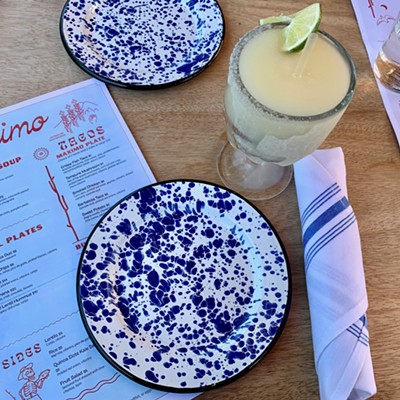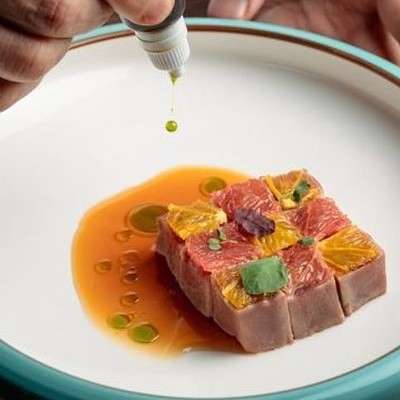Five pieces of fried chicken, glistening with a spicy red glaze and sprinkled with sesame seeds, arrive piping hot with cubes of pickled daikon and a side of french fries. At Lim’s Chicken, the chicken is dipped in a bath of hot oil twice, which locks in the natural juices while fully committing to the birth of a crispy outer shell. They call it the new KFC, or Korean fried chicken, and Lim’s version meets the standard when it comes to a good fried chicken.
Korean fried chicken is not new or rare in Houston; in fact, the city is home to a handful of restaurants, such as Toreore in Koreatown (which has been around since 2008), Dak & Bop in the Museum District and the more recent arrival BonChon in Katy, all dedicated to the double-fried craft, as well as places that like to dabble with KFC on the side.
The fried chicken at Lim’s is offered in two quantities: half or whole. With a half order come a leg, a thigh, a wing and the breast, cut into two parts. The art of frying chicken the Korean way involves a combination of cornstarch and flour, frying and re-frying, and a good, sticky sauce with heat to finish up.
We ordered several versions of the KFC to check out the flavors and the levels of spice. Choices include original, spicy, extra spicy and garlic soy. On our first visit, a half order of the original and the spicy hit the table. At lunchtime, the sparse dining area was filled with Korean K-pop tunes in the background. Only one other party sat behind us, and I spied the guy putting on a pair of plastic gloves in preparation for eating his fried chicken. We contemplated ordering gloves as well, but decided to take our chances.
Both plates of chicken arrived with a side of thin, crispy McDonald’s-worthy fries. I was surprised and encouraged when the server happily shared that, yes, Lim’s makes its own fries.
The original appeared to be the crispier of the two batches. Both versions were freshly dropped and made-to-order. Pavlovian conditioning is a real thing; it gets me every time. There’s something about taking that first bite of scorching-hot food, fresh out of the oven, that I cannot resist. Roof-of-my-mouth burnt…ev-ery-time; it’s my bell.
The spicy chicken is coated with a spicy, dark-red, sticky sauce. The flavor is very good. The heat, although very noticeable, is more savory than spicy. A common ingredient in Korean cooking is gochujang, which is used to kick things up a notch in marinades and dipping sauces. A common rendering of KFC sauce combines gochujang, soy sauce, vinegar, sugar, garlic, ginger and sesame oil, the measurements varying from recipe to recipe. We enjoyed the spicy version over the original.
On a second visit, the extra spicy and garlic soy were sampled. The garlic soy was not my favorite, coming off more sweet than garlicky. The extra spicy was ordered only to judge if we indeed needed those gloves after all. The heat level was turned up, but overall, it tasted more like a honey-barbecue.
After trying all the flavors on the menu, we determined the spicy to be our favorite sauce. The meat of the fried chicken itself didn’t carry enough flavor, but when coated with the sauce, the KFC experience came full circle. The addition of the pickled daikon is a great way to cool the heat of the sauce in between bites of the chicken.

At Lim’s, banchan includes three items: spicy cucumber, thin fish cake patties and kimchi.
Photo by Troy Fields
The kimchi is delicious. Sometimes the spices can be a bit overpowering, but the Lim’s version is very well made. The fish patty and cucumber are typical representations. These morsels are a thoughtful
addition to any Korean meal.
The selection of traditional Korean dishes is extensive. Most of the dishes commonly found at other Korean restaurants made an appearance. We ordered the bibimbap, rice with several samples of the banchan and marinated pieces of beef, all topped with a sunny-side up egg and served inside a hot stone bowl, and the galbi gui, beef short ribs.
One of the marks of a good bibimbap is the crunchy bottom of the sizzling rice that gets toasted by the heat of the stone bowl in which it’s presented or cooked. This one lacked that layer of crust. The server brought us the dolsot bibimbap, instead of the plain bibimbap that was ordered, which costs an extra $2, but included a house spicy sauce on the side. That sauce was very tasty and made its way onto more than the bibimbap.
The gabli gui is a dozen or so thinly sliced pieces of beef short rib, presented on a sizzling plate and topped with a heap of barely cooked white onion. It comes with a bowl of steamed rice.
We sampled both appetizers on the menu. The haemul pajeon is a traditional Korean item, pan-fried with pieces of cut-up shrimp and squid in the mix. The pancake is served with a sauce similar to a tangy, soy or ponzu dumpling sauce.
The mandoo consisted of 11 pan-fried dumplings stuffed with a mixture of glass noodles, pork and spices. A soy-based sauce accompanied the dumplings. They were good, nothing special, but fried well, and the sauce was tasty.
A selection of imported beers is offered, including three Korean beers, Hite, Casee and OB Premier. A short list of domestics, an Angry Orchard Cider, soju and a variety of mak gul li (a more traditional Korean rice wine) round out the beverages. A peach-flavored mak gul li was brought to the table, still in its plastic bottle and presented in a small bucket of ice to keep it cool. Two copper bowls with handles were delivered as well. They were of a significant size, which prompted me to ask the server exactly what they were for. We didn’t want to be those people drinking out of intended rice bowls. The wine was refreshing; the peach was a good choice.
The restaurant is bright and cheery, with a tiny three-stool area bar set in the front to the side. A floor-to-ceiling blackboard wall is adjacent to the cash register space. I spotted a few “so-and-so’s were here” in cutesy handwriting as well as a “GASTROPUB,” written in all caps across the board. I’m not sure I’d call Lim’s a gastropub, but by definition I guess it could pass as one, with beer, wine and not your typical bar food.
Lim’s Chicken is touted as South Korea’s first fried chicken franchise, emerging in 1977 in Seoul’s Shin-sae-gye Department Store. Judging from the company’s online profile, Lim’s doesn’t consider itself to be fancy, just faithful to its customers, using “healthy, fresh and best-quality chickens” in preparation and cooking. We thought it was good. The spicy sauce on the chicken was fantastic, but skip the original flavor and definitely try the kimchi.
Lim’s Chicken
10603 Bellaire, Suite B107, 281-575-8077, limschickenusa.com. Hours: Monday through Sunday, 11 a.m. to 10 p.m.
Original fried chicken (half order) $10.95
Marinated fried chicken (half order) — spicy $11.95
Garlic soy fried chicken (half order) $11.95
Marinated fried chicken (half order) — extra spicy $11.95
Mandoo (fried dumplings) $7.95
Dolsot bibimbap $10.95
Galbi gui (beef short ribs) $21.95
Haemul pajeon (seafood pancake) $12.95
Peach mak gul li $12








